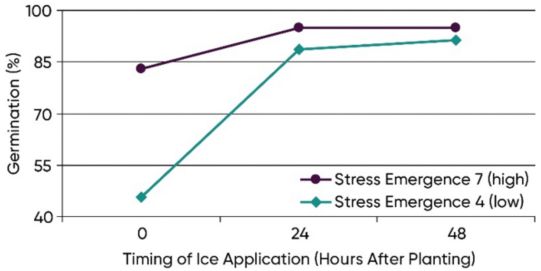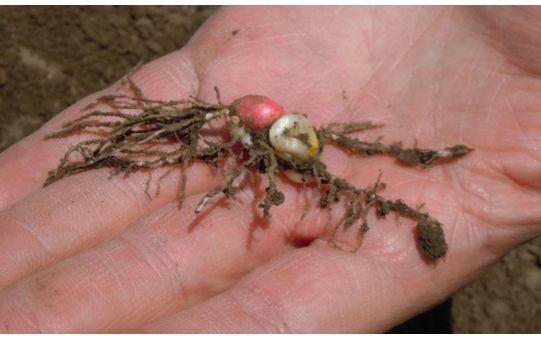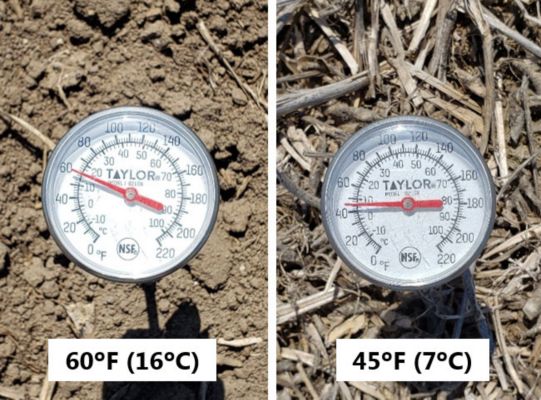Corn germination and emergence are optimal when soil temperatures are approximately 85°F to 90°F. But to maximize yield, many farmers have to risk planting in cooler April weather. Low temperatures during planting can impose significant stress on corn seedlings.
Corn seed is susceptible to cold stress after planting and throughout imbibition. Planting just before a stress event, such as a cold rain or snow, can cause significant stand loss. The chances of establishing a good stand are greatly improved if seeds are able to germinate at least one day in warmer, moist conditions before a cold-stress event.
“We want to see at least a minimum soil temperature of 50°F to get corn out of the ground while minimizing chance of injury,” said Aaron Vammer, Pioneer Field Agronomist.
Early season stress can promote seedling disease if certain conditions are met, such as the presence of inoculum or prolonged cool, wet conditions. Injury to emerging seedlings will also promote seedling disease. Injury can be caused by chilling, such as imbibitional damage, or insect feeding, such as seedcorn maggots, white grubs and wireworms.
Planting date is one of the most important factors in stand establishment. The likelihood of reduced stands is greatest when planting into cold, wet soils or directly before cold, wet weather is expected.
“To reduce the chance of cold injury, check the five-day forecast for a potential temperature drops,” Vammer said. “If you are going to plant into cold soils, plant hybrids with high stress emergence scores and the appropriate seed treatment.”Cold Soils Cause Emergence Stress
- Corn is a warm season crop – germination and emergence are optimal when soil temperatures are approximately 85-90ºF (29-32ºC).
- In North America, soil temperatures at planting are usually well-below this range, which imposes significant stress on corn emergence and seedling health.
- Hybrid genetics provide the basis for tolerance to cold stress; however, even with the best genetics and highest seed quality, environmental factors can still reduce stand establishment.
- It is generally recommended that growers plant corn when soil temperatures are at or above 50ºF (10ºC); however, soil conditions after planting are also critical.

Figure 1. Critical environmental, genetic, and seed quality factors that affect stand establishment.
Genetic Differences in Stress Tolerance
- Pioneer® brand corn products are rated for stress emergence (SE) to help farmers manage early-season risk.
- Choosing hybrids with higher stress emergence scores can help reduce vulnerability to stand loss due to cold soil temperatures.
- To generate stress emergence ratings, hybrids are tested over multiple years and environments, beginning several years before commercialization.
- In trials conducted at several northern locations in 2018, both low SE and high SE hybrids experienced stand loss with increasing cold stress; however, hybrids with higher stress emergence (SE 6) were able to maintain higher stands than those with lower stress emergence (SE 4) (Figure 2).

Figure 2. Average stand establishment for high and low stress emergence score hybrids in six stress emergence locations in 2018. Locations are sorted from least stressful (left) to most stressful (right) based on average early stand.
Timing of Cold Stress
- Planting just before a stress event such as a cold rain or snow can cause significant stand loss.
- The corn seed imbibes water needed for germination very rapidly – most water is imbibed within the first 30 minutes after exposure to saturated conditions (Figure 3).

Figure 3. Amount of water uptake by corn seed during the first three hours after submersion in 50°F (10°C) water.
- If this early imbibition occurs at cold temperatures, it could kill the seed or result in abnormal seedlings.
- Growers should not only consider soil temperature at planting, but also the expected temperature when seed begins rapidly soaking up water.
- Seed planted in warmer, dry soils can still be injured if cold, wet conditions occur immediately after planting.
- The chances of establishing a good stand are greatly improved with at least 24 hours of warmer, moist conditions for germination to occur before a cold stress event (Figure 4).

Figure 4. Germination of two hybrids with stress emergence scores of 7 (above average) and 4 (below average) following imbibitional chilling induced by melting ice. Ice was applied immediately after planting (0 hours) or after 24 hours or 48 hours of pre-germination in warm conditions.
Soil Temperature Fluctuations
- Farmers are often able to plant fields with sandier soils earlier in the spring because they dry out faster than heavier soils.
- Sandy soils are more porous and have lower water holding capacity than heavier soils. As such, they tend to experience wider temperature fluctuations, especially on clear, cold nights.
- These wider temperature fluctuations can result in a greater risk of stand loss from cold stress in sandy soils.
- In 2015, soil temperatures were recorded at a 2-inch depth at a research location with sandy soils near Eau Claire, WI.
- Daytime soil temperatures reached acceptable levels for corn development (over 50°F, 10°C) for the first week after planting.
- However, the early morning soil temperatures dipped to as low as 38ºF (3ºC), and on some days the soil temperature difference between 6 AM and 6 PM was over 20ºF (-7ºC) (Figure 5).
- An average 25% stand loss was observed at this location, demonstrating that day-night temperature fluctuation after planting can pose an added stress on germinating corn.
- Farmers should be aware of expected night temperatures when choosing a planting date.

Seedling injury caused by temperature fluctuations.

Figure 5. Soils temperatures at 6 AM and 6 PM for seven days after planting in a stress emergence field location near Eau Claire, WI.
Impact of Crop Residue
- Crop residue tends to hold excess water and can significantly lower soil temperature in the spring, depriving seed of critical heat units needed for rapid emergence.
- In 2011, soil temperature data loggers were placed in a field near Perry, IA to assess early soil temperatures in a strip-till field.
- One data logger was placed in the tilled planting strip (low residue) and one was placed in between the rows under high residue.
- From April 1 to April 30, soil under low residue was able to accumulate 99 soil GDUs, while adjacent soil under heavy residue accumulated only 28 soil GDUs.
- In mid-April 2019, a 15-degree midday temperature difference was noted in the same field between soil under low residue and soil ~20 yards away under soybean residue (Figure 6).

Figure 6. A 15-degree Fahrenheit temperature difference was observed midday on April 15, 2019 in a central Iowa field between soil under no residue and soil under heavy residue.
Related Content
Tips on How to Reduce Early-Season Emergence Stress





